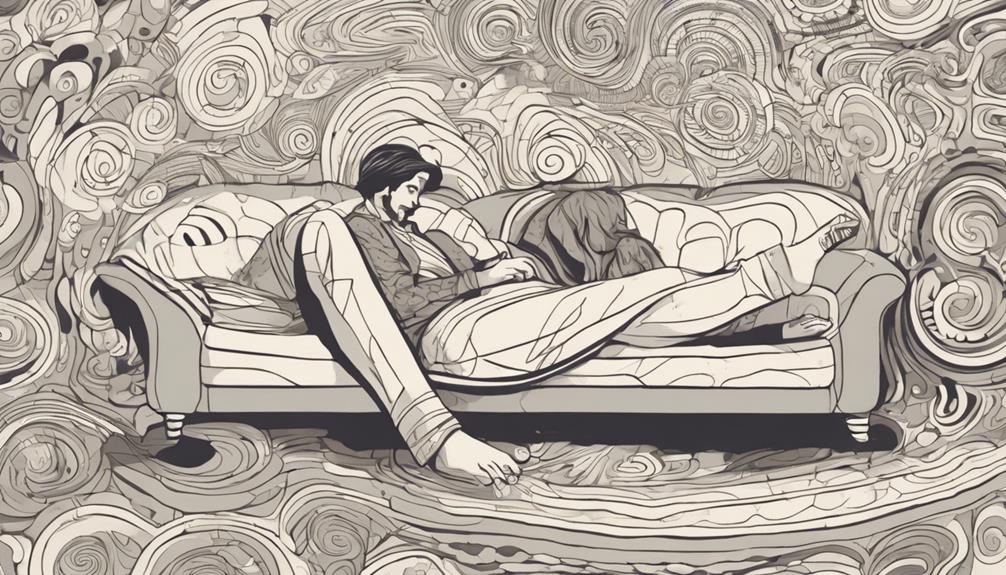Tickling hypnosis is a unique therapy that combines the benefits of tickling and hypnosis to induce deep relaxation. By triggering a trance-like state, it promotes mental and physical well-being by reducing stress levels and promoting muscle relaxation. Laughter therapy through tickling releases endorphins, enhancing the relaxation response similar to meditation. Understanding the dynamics of the trance state and suggestibility in hypnosis play an essential role in maximizing therapeutic benefits. Techniques like light tickling motions and neural pathway stimulation aim to achieve balance and emotional wellness. Further exploration into tickling hypnosis can uncover its full potential in therapy and relaxation.
The Power of Tickling Hypnosis
The phenomenon of tickling hypnosis encompasses a fascinating blend of psychological manipulation and suggestibility that can induce a state of heightened relaxation and receptiveness in individuals. Tickling sensations, when used in a hypnotic context, have been found to trigger a unique response in the brain, leading to a trance-like state characterized by increased suggestibility. This state can be utilized to promote relaxation and alleviate stress through laughter therapy, where the act of tickling induces laughter, releasing endorphins and promoting a sense of well-being.
Studies have shown that the hypnotic effects of tickling can elicit a relaxation response in individuals, similar to other forms of meditation or guided imagery. By stimulating the nervous system through tickling, individuals may experience a release of tension and an increase in feelings of calmness and tranquility. This relaxation response can have profound effects on both mental and physical well-being, making tickling hypnosis a potentially valuable tool in promoting overall health and reducing stress levels.
Understanding the Trance State
How does the trance state induced by tickling hypnosis impact an individual's suggestibility and receptiveness to hypnotic suggestions?
The trance depth achieved during tickling hypnosis plays a pivotal role in influencing an individual's responsiveness to hypnotic suggestions. When a person is in a trance state, their consciousness is altered, allowing for deeper subconscious exploration. This altered state of consciousness heightens suggestibility, making individuals more receptive to hypnotic suggestions.
By combining tickling sensations with hypnotic techniques, practitioners can induce a trance state that promotes relaxation and focus, enhancing the effectiveness of hypnotic suggestions.
During tickling hypnosis, the individual's subconscious mind becomes more accessible, enabling a skilled practitioner to guide them towards specific therapeutic outcomes. The depth of trance achieved through tickling hypnosis can vary, with deeper trance states often leading to more profound subconscious exploration and receptiveness to hypnotic suggestions.
Understanding the dynamics of the trance state induced by tickling hypnosis is vital for maximizing the benefits of this unique therapeutic approach.
Benefits of Tickling Hypnosis

Research has shown that tickling hypnosis can offer a range of therapeutic benefits for individuals seeking alternative forms of mental health support. One of the key benefits of tickling hypnosis is its potential as a form of physical therapy. Tickling can stimulate the nervous system, increase blood flow, and promote muscle relaxation, making it a unique way to address physical tension and stiffness.
In addition to its physical therapy benefits, tickling hypnosis is also effective in providing stress relief. The combination of tickling sensations and hypnosis techniques can help individuals enter a deep state of relaxation, reducing stress levels and promoting a sense of calmness. This can be particularly beneficial for individuals experiencing high levels of stress or anxiety.
Techniques for Inducing Relaxation
Tickling hypnosis utilizes a variety of techniques to induce relaxation in individuals seeking alternative forms of mental health support. By incorporating specific tickling techniques, this form of therapy aims to trigger the relaxation response in the body, promoting stress relief and overall well-being.
One common technique used in tickling hypnosis is light, gentle tickling motions on different parts of the body, such as the arms, back, or feet. These light touches can help release tension, reduce anxiety, and create a sense of comfort for the individual undergoing the therapy.
Tickle therapy, as a component of tickling hypnosis, focuses on stimulating the nervous system in a way that promotes relaxation and eases stress. The sensation of being tickled can activate various neural pathways that contribute to the release of endorphins and other feel-good neurotransmitters, further enhancing the relaxation response in the body.
Through these techniques, tickling hypnosis aims to provide individuals with a unique and effective method for achieving mental and emotional balance.
Exploring Suggestibility in Hypnosis

An essential aspect of hypnosis involves investigating the varying levels of suggestibility exhibited by individuals undergoing hypnotic induction. Suggestibility tests play a pivotal role in understanding how receptive a person is to hypnotic suggestions.
One interesting phenomenon observed in suggestibility testing is the tickling response. Individuals with higher levels of suggestibility may exhibit heightened ticklishness or even experience tickling sensations without any physical touch during hypnosis.
Studies have shown a correlation between suggestibility levels and brainwave activity. Research indicates that individuals with higher suggestibility levels tend to exhibit changes in brainwave patterns during hypnosis compared to those with lower suggestibility.
These alterations in brain activity may reflect the increased responsiveness of suggestible individuals to hypnotic suggestions.
Applications in Therapy and Entertainment
The utilization of tickling hypnosis both in therapy and entertainment settings demonstrates the versatility and potential efficacy of this approach in harnessing suggestibility for therapeutic or amusement purposes.
Concerning therapeutic benefits, tickling hypnosis has shown promise in the domain of mental health by incorporating laughter therapy into sessions. Laughter therapy, also known as humor therapy, has been linked to various mental health benefits such as stress reduction, improved mood, and enhanced overall well-being.
In a therapeutic setting, tickling hypnosis can be utilized as a tool to facilitate relaxation, enhance positive emotions, and promote a sense of connection between the hypnotist and the individual undergoing the session. By inducing laughter through tickling hypnosis, individuals may experience a release of tension and an uplift in mood, which can contribute to the overall therapeutic process.
Moreover, in entertainment contexts, tickling hypnosis can serve as a unique and engaging form of amusement, blending the elements of hypnosis and laughter to create an entertaining experience for audiences.
This dual nature of tickling hypnosis highlights its potential to cater to both therapeutic and entertainment needs, showcasing its adaptability and value in diverse settings.
Conclusion
To sum up, tickling hypnosis offers a distinct method to promote relaxation and delve into suggestibility in the trance state.
The advantages of tickling hypnosis reach into therapy and entertainment realms, making it a flexible tool in different environments.
By grasping the methods for promoting relaxation and utilizing suggestibility, practitioners can tap into the potential of tickling hypnosis for therapeutic and entertainment purposes.
Tickling hypnosis unveils a realm of possibilities, where the mind can be guided to new levels of relaxation and suggestibility.
Dr. John Renoldson is a distinguished professor of Clinical Research Hypnotherapy He holds a PhD in Clinical Psychology and specializes in hypnotherapy and scientific research to enhance therapeutic outcomes. Dr. Renoldson has authored numerous peer-reviewed articles on the efficacy of hypnosis in treating conditions.




